Swordfish - Mediterranean Sea|
| Fact Sheet Title Fact Sheet |
| | | Swordfish - Mediterranean Sea |
 | Swordfish in the Mediterranean Sea |
| | Data Ownership | | This document owned by International Commission for the Conservation of Atlantic Tunas (ICCAT), provided and maintained by Standing Committee on Research and Statistics , is part of ICCAT SCRS Reports data collection. |
| | ident Block | ident Block | | | | Species List: | | Species Ref: en - Swordfish, fr - Espadon, es - Pez espada, ru - Меч-рыба |
|
|
| ident Block Swordfish - Mediterranean Sea Map tips - Click on
 to turn layers on and off to turn layers on and off - Double-click to zoom in
- Drag to pan
- Hold down the shift key and drag to zoom to a particular region
| iccat Smu |
|---|
| SWO_MED | Mediterranean Sea |
|---|
|
|
|
|
| | Aq Res | Biological Stock: Yes Value: Sub-Regional
Management unit: Yes Reference year: 2015
|
| Considered a management unit: An aquatic resource or fishery is declared as [Fishery] Management Unit if it is effectively the focus for the application of selected management methods and measures, within the broader framework of a management system. According to the FAO Glossary for Responsible Fishing, "a Fishery Management Unit (FMU) is a fishery or a portion of a fishery identified in a Fishery Management Plan (FMP) relevant to the FMP's management objectives." FMU's may be organised around fisheries biological, geographic, economic, technical, social or ecological dimensions , and the makeup and attribute of a fishery management unit depends mainly on the FMP's management objectives. |
| Jurisdictional distribution: Jurisdictional qualifier (e.g. "shared", "shared - highly migratory") of the aquatic resource related with its spatial distribution. |
| Environmental group: Classification of the aquatic resource according to the environmental group (e.g. pelagic invertebrate, or demersal fish) to which the species belong. |
| Reference Year: The Reference Year is the last year considered in the stock assessment and/or fishery status. |
| | | | | | History In the last 4 years the Mediterranean swordfish production is stable around to 10,000 t and it is comparable to that observed for much larger areas such as the North and South Atlantic. This may suggest that the biological and oceanographic conditions prevailing in the Mediterranean favour the high productivity of large pelagic fish. The most recent assessment was conducted in 2016, making use of the available catch, effort and size information through 2015. The present report summarizes assessment results and readers interested in more detailed information on the state of the stock should consult the report of the latest stock assessment session. Habitat Bio Climatic Zone: Temperate. Horizontal Dist: Oceanic. Vertical Dist: Pelagic. Research results based on genetic studies have demonstrated that Mediterranean swordfish compose a unique stock separated from the Atlantic ones, although there is incomplete information on stock mixing and boundaries. Although mixing between stocks is believed to be low and generally limited to the region around the Strait of Gibraltar, past biological and genetic studies have suggested the possible occurrence of mixing between the Mediterranean and North Atlantic stocks west of the 05°W boundary separating the two stocks. It is very likely that an important fraction of fish caught in this area belongs to the Mediterranean stock but further studies are needed to identify the degree of mixing among stocks. According to previous knowledge, the Mediterranean swordfish have different biological characteristics compared to the Atlantic stock. The growth parameters are different, and the sexual maturity is reached at younger ages than in the Atlantic. In the western Mediterranean, mature females as small as 110 cm LJFL have been observed and the estimated size at which 50% of the female population is mature occurs at about 140 cm. According to the growth curves used by the SCRS, these two sizes correspond to 2 and 3.5 year-old fish, respectively. Males reach sexual maturity at smaller sizes and mature specimens have been found at about 90 cm LJFL. Based on the fish growth pattern and the assumed natural mortality rate of 0.2, the maximum yield would be obtained through instantaneous fishing at age 6, while current catches are dominated, in terms of number, by fish less than 4 years old. The Committee is working on updating the existing length-weight relationships and some preliminary analysis that has been done indicates that there are differences among areas; thus Mediterranean-wide equations will be estimated from data sets integrating information from different areas. Geo Dist Geo Dist: Highly migratory Swordfish are distributed widely in the Atlantic Ocean and Mediterranean Sea, in coastal and offshore areas, mostly ranging from 45ºN to 45ºS, and range from Canada to Argentina on the western side, and from Norway to South Africa on the eastern side (Figure 1). Water Area Overview Spatial Scale: Sub-Regional Water Area Overview  | | Water Area Overview Swordfish - Mediterranean Sea
| iccat Smu | SWO_MED: Mediterranean Sea |
| | | | | | Water Area Overview |
Water Area OverviewSwordfish - Mediterranean Sea Aq Res Struct Biological Stock: Yes A Workshop on swordfish stock structure took place in Crete in early 2006, in response to Resolution by ICCAT on the clarification of the stock structure and boundaries between the swordfish stocks in the Atlantic [Res. 99-03], at which 13 scientific documents on swordfish biology were presented. The results of the research presented gave general support to the stock structure currently assumed for Atlantic Swordfish (Mediterranean and North and South Atlantic stocks). The Workshop also noted that while there was some mixing between Atlantic and Mediterranean stocks near the Straits of Gibraltar, there was strong evidence that the Mediterranean is genetically distinct from the Atlantic, Pacific and Indian Ocean stocks. Research results based on genetic studies have demonstrated that Mediterranean swordfish compose a unique stock separated from the Atlantic ones, although there is incomplete information on stock mixing and boundaries. However, mixing between stocks is believed to be low and generally limited to the region around the Strait of Gibraltar. According to previous knowledge, the Mediterranean swordfish have different biological characteristics compared to the Atlantic stock. The growth parameters are different, and the sexual maturity is reached at younger ages than in the Atlantic. A study that was presented during the latest assessment session suggested that the growth pattern of swordfish in the Strait of Gibraltar was very similar to that obtained from past studies in various Mediterranean areas. Given the existing growth differences among Atlantic and Mediterranean swordfish, this suggests that the majority of fish caught in this area are most likely belonging to the Mediterranean stock. However, further studies are needed to identify the degree of mixing among stocks. Size at age estimates from a recently published growth study performed in the Aegean Sea were in general agreement with those predicted by the model adopted in ICCAT. 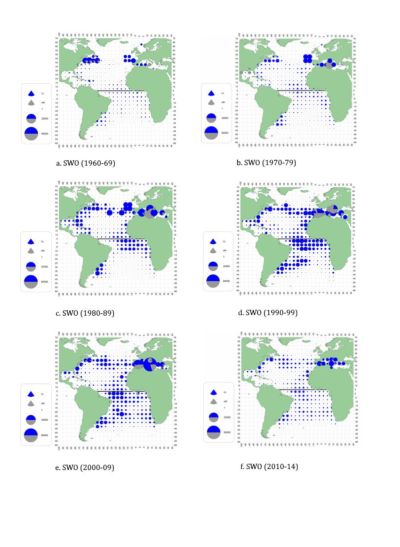 | Figure 1 Geographic distribution of swordfish cumulative catch (t) by major gear and decade.  |
Exploit Description of fisheries Mediterranean swordfish landings showed an upward trend from 1965-1972, stabilized between 1973-1977, and then resumed an upward trend reaching a peak in 1988 (20,365 t; Table 1, Figure 2). The sharp increase between 1983 and 1988 may be partially attributed to improvement in the national systems for collecting catch statistics; thus earlier catches may be higher than those appearing in Task I tables. Since 1988 and up to 2011, the reported landings of swordfish in the Mediterranean Sea have declined fluctuating mostly between 12,000 to 16,000 t. In the last four years (2012-2015), following the implementation of the three-month fishery closure and the establishment of the list of authorized vessels, overall fishing effort has been decreased and catches are around to 10,000 t. In general, these catch levels are relatively high and similar to those of bigger areas such as the North Atlantic. This could be related to higher recruitment levels in the Mediterranean than in the North Atlantic, different reproduction strategies (larger spawning areas in relation to the area of distribution of the stock) and the lower abundance of large pelagic predators (e.g. sharks) in the Mediterranean. Updated information on Mediterranean swordfish catch by gear type is provided in Table 1 and Figure 2. The provisional Task I catch for 2015 that was used in the assessment was 9,966 t, which is among the lowest annual catches since 1983. The biggest producers in the recent years (2003-2015) are Italy (45%), Morocco (14%), Spain (13%), Greece (10%) and Tunisia (7%). Also, Algeria, EU-Cyprus, EU-Malta and Turkey have fisheries targeting swordfish in the Mediterranean. Minor catches of swordfish have also been reported by Albania, EU-Croatia, EU-France, Japan, and Libya. In the recent years (2003-2015), the main fishing gears used are longlines (on average, representing 84% of the annual catch) and gillnets. Since 2012, gillnets have been eliminated following ICCAT recommendations for a general ban of driftnets in the Mediterranean. Minor catches are also reported from harpoon, trap and fisheries targeting other large pelagic species (e.g. albacore). From 2007-2010 a mesopelagic longline gear has been gradually introduced and nowadays has partially replaced the surface longline gear in several Italian and Spanish swordfish fleets. This is particularly noteworthy, as these fisheries are among the largest within the stock area, and the changes have implications for the use of catch rates as indices of abundance in the stock assessments. Standardised CPUE series from different longline fisheries targeting swordfish that were used in the 2016 stock assessment session, did not reveal any overall trend over time (Figure 3). It should be noted that CPUE series did not cover the earlier years of the reported landings. No trend over the past 30 years was identified regarding the mean fish weight in the catches (Figure 4). 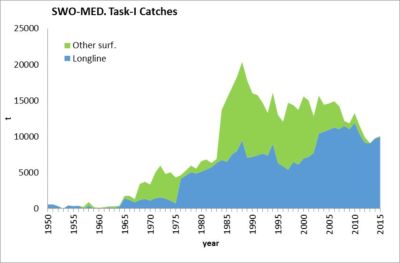 | Figure 2 Cumulative estimates of Task I swordfish catches (t) in the Mediterranean by major gear types, for the period 1950-2015. Misreporting may occur in the earlier period (up to the middle 1980s).  |
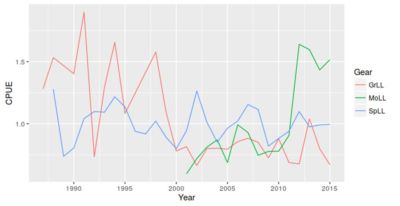 | Figure 3 Relative abundance indices used in the assessment of the Mediterranean swordfish. All indices are scaled to their individual means to facilitate comparison of trends and relative degree of variability. GrLL=Greek longlines, SpLL=Spanish longlines, MoLL=Moroccan longlines.  |
 | Figure 4 Time series of mean fish weight (kg) in the catches.  |
Bio Assess Assess Models It should be noted that the assessment results and projections presented here are based on the results of the 2016 assessment, including data up to 2015 that were available at the time of the assessment (July 2016). Under different assumptions about natural mortality rates and reporting levels of undersized fish in the catch, age-structured analysis (XSA) indicated that current SSB levels are much lower than those in the 80s, although no trend appears since then. XSA results indicate that recruitment shows a declining trend in the last decade, while stock biomass remains stable at low levels that are about 1/3 of that in the mid 1980s (Figure 5). There appears to have been a recent decline in F in the last decade. Results of equilibrium yield analyses based on the XSA assessment indicated that the stock is both overfished and subject to overfishing, with a 100% probability. Current (2015) SSB is less than 15% of BMSY and F is almost twice the estimated FMSY (Figure 6). Results indicate that the stock is overfished throughout the whole period considered in the XSA assessment (1985-2015). The Committee again noted the large catches of small size swordfish, i.e. less than 3 years old (many of which have probably never spawned) and the relatively low number of large individuals in the catches. Fish less than three years old usually represent 50-70% of the total yearly catches in terms of numbers (Figure 7). A reduction of the volume of juvenile catches would improve yield per recruit and spawning biomass per recruit levels. 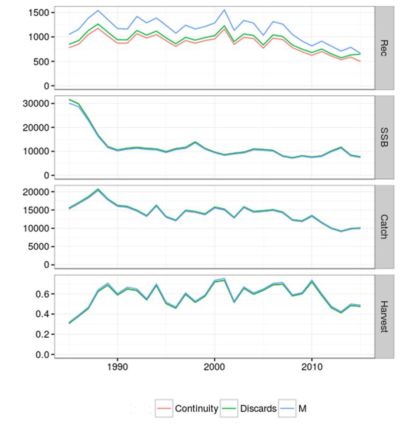 | Figure 5 Estimates of historic time series of recruitment (thousands of fish), SSB (t), catch (t) and average fishing mortality (harvest) of ages 2-4 from the three XSA runs (Continuity=constant natural mortality, Discards=assuming discard rate of 4 zero-age fish/t, M=natural mortality varies with age).  |
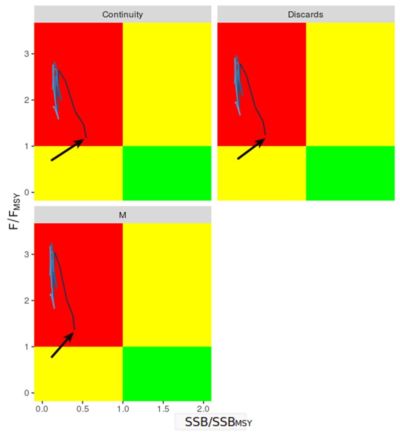 | Figure 6 Time trends for stock status (SSB/SSBMSY and F/FMSY) derived from the three XSA runs. (Continuity=constant natural mortality, Discards=assuming discard rate of 4 zero-age fish/t, M=natural mortality varies with age). Arrows indicate the ratio estimates at the beginning of the studied period.  |
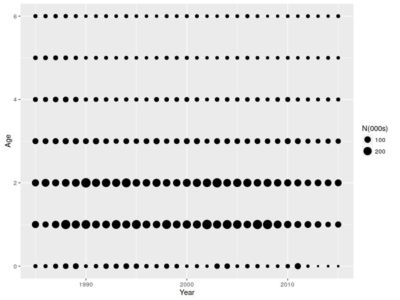 | Figure 7 Catch numbers at age by year.  |
Results Projection Outlook The assessment of Mediterranean swordfish indicates that the stock is overfished and suffering overfishing. The stock has been in this state since the late 1980s because of the large catches in the 1980s and the selection pattern which captures many immature fish. Catches of immature fish remain high and the greatest mortality is suffered by fish of age 3. Recruitment has been declining for the last 10 years, and recent recruitments have been lower than the level expected to be available given recent levels of SSB. Based on the stock status estimates, once the stock is rebuilt, a reduction of current F to the FMSY level would result in a substantial (about five times) long term increase in SSB. The above findings, however, should be faced with caution as there is considerable uncertainty in regards to the possible levels of future recruitment given the assumed high steepness of the S/R relationship. It is unclear whether the most recent low levels are associated with a change in stock productivity, if they are an artefact of the estimation process, or if they are due to a temporary reduction in recruitment that could be reverted naturally by a series of positive recruitment anomalies. It is worth mentioning that the estimated SSBMSY levels are twice as much higher than the SSB values estimated before the full expansion of the fishery. Correspondingly, the estimated FMSY is lower than all historical F values. Given the uncertainties on optimum SSB level estimates and the rapid fishery expansion in the 1980s, which resulted in severe stock biomass declines, the SSB levels before the expansion of the fisheries may be also considered as a BMSY proxy for the stock. These levels are around 30,000 t, more than 50% lower than the currently estimated BMSY value. (~63,000 t). Projections of 20% fishing mortality reductions based on highly-aggregated data derived from the age-structured assessment assuming the current exploitation pattern and the assumption of reverting recruitment to the 1980s levels, according to estimated S/R relationship, are forecast to be beneficial in moving the stock condition closer to the Convention objective, resulting in substantial SSB increases in the medium-long term (8-12 years) and bringing SSB to the late 80s’ levels. Projection results are summarized in Figure 8.  | Figure 8 Projections based on the current selection pattern and three different F (harvest) levels: status quo (blue), 80% of current F (red) and FMSY (green). Estimates are based on the XSA assessment assuming a discard rate of 4 zero-age fish/t. Lines correspond to median estimates and ribbons to inter-quartiles.  |
Management Management unit: Yes Effects of current regulations ICCAT imposed a Mediterranean-wide one month fishery closure for all gears targeting swordfish in 2008, followed by a two-month closure since 2009. Through Recommendations 11-03 and 13-04 the Commission has adopted additional management measures intended to bring the stock back to levels that are consistent with the ICCAT Convention objective. Those measures include an additional one month closure accompanied by minimum landing size regulations, a list of authorized vessels, and specifications on the technical characteristics of the longline gear. Several countries have also adopted additional fishery restrictions at the national level. The European Union introduced a driftnet ban in 2002 and in 2003 ICCAT adopted a recommendation for a general ban of this gear in the Mediterranean (Rec. 03-04). Rec. 04-12 forbids the use of various types of nets and longlines for sport and recreational fishing for tuna and tuna-like species in the Mediterranean. After the adoption of the aforementioned recommendations, reported catches have decreased significantly from the 2000s’ level, being the catches of the period 2012-2015 among the lower of the last three decades. In addition, reported catches of juvenile swordfish of less than 90 cm has also decreased on average 54% in the last two years compared with the levels of the decade of 2000s. However, the regulations foreseen in the above recommendations appear to be insufficient in bringing the stock to levels consistent with the Convention objective. Advice Over the last 25 years biomass levels appear to be rather stable at low levels. This situation has remained the same since the previous assessment of 2014. However, fishing mortality levels have shown a declining trend since 2010. Assessment of stock status and reference points were done under the assumption that recruitment levels can come back up to the levels seen in the past (1980's and 1990's). Under such assumption the stock is currently overfished and suffering overfishing. According to the Commission objectives the stock requires rebuilding and fishing mortality has to be reduced in accordance with Rec. 11-13. The level of the stock to be rebuilt, is contingent on the assumption on future recruitment which is highly uncertain. In order for rebuilding to start taking place there will be a need for substantial reductions in harvest. Additionally, for the SCRS to be able to reduce uncertainty in regards to future recruitment, there will be a need to increase monitoring of landings and discards. Since the establishment of minimum landing sizes, the discard levels of undersized swordfish may have increased. Additionally, it has been shown that high swordfish by-catches composed mostly of undersized individuals exist in albacore fisheries operating in the autumn and winter months coinciding with the swordfish closing season. As the swordfish fishery closure aims to the protection of recruits, the impact of those fisheries needs to be taken into account in future management recommendations. | MEDITERRANEAN SWORDFISH SUMMARY | | Maximum Sustainable Yield | 19,6831 | | Current (2015) Yield | 10,068 t (9,966 t2) | | SSBMSY | 63,426 t1 | | FMSY | 0.251 | | Relative Spawning Biomass (SSB2015/SSBMSY) | 0.12 1 | Relative Fishing Mortality
F2015/FMSY
F2015/F0.1 | 1.85 1
2.64 1 | | Management measures in effect | Driftnet ban [Rec. 03-04] Three month fishery closure, gear specifications (number and size of hooks and length of gear), MLS regulations, and a list of authorized vessels [Rec. 13-04].3 | 1Highly uncertain estimates based on the XSA and equilibrium analyses. 2As of September 2014. 3Certain additional fishery restrictions are implemented at the national level. Sources Standing Committee on Research and Statistics (SCRS). “Mediterranean Swordfish, Executive Summary.” Madrid, Spain October 3 - 7 2016. ICCAT  http://www.iccat.int/Documents/Meetings/Docs/2016_SCRS_ENG.pdf http://www.iccat.int/Documents/Meetings/Docs/2016_SCRS_ENG.pdf |
|
| |
|
|





